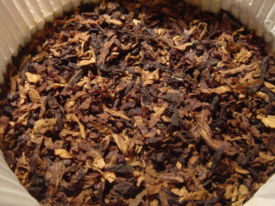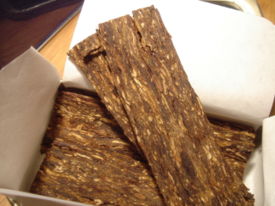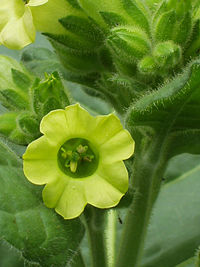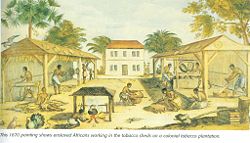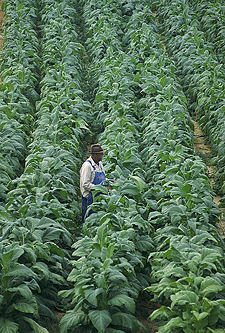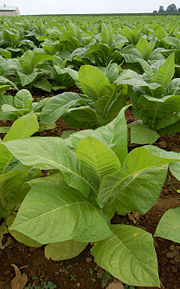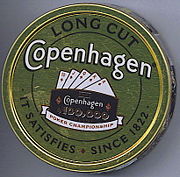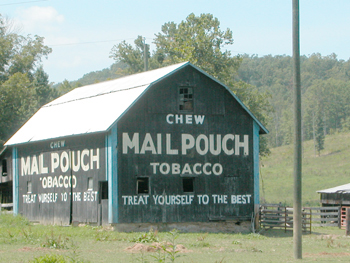Tobacco
2008/9 Schools Wikipedia Selection. Related subjects: Plants
Tobacco is an agricultural product processed from the fresh leaves of plants in the genus Nicotiana. It is most commonly smoked in the form of cigarettes or cigars. Tobacco has been growing on both American continents since about 6000 BC and was used by native cultures by around 3000 BC. It has been smoked, in one form or another, since about 3000 BC. Tobacco has a long history of use in Native American culture, and played an important role in the political, economic, and cultural history of the United States of America.
Dried, cured, and unprocessed tobacco is commercially available all over the world. Smoke from burning, or otherwise heated, tobacco can be inhaled in the forms of cigarettes, cigars, stem pipes, water pipes, and hookahs. Tobacco can also be chewed, dipped (placed between the cheek and gum), or sniffed into the nose as finely powdered snuff. Many countries set minimum legal smoking ages, regulating the purchase and use of tobacco products. Bhutan is the only country in the world where tobacco sales are illegal. According to the World Health Organization, tobacco smoke is the second biggest cause of death worldwide, and is reported to have been responsible for the deaths of 100 million people in the 20th century.
All methods of tobacco consumption result in varying quantities of nicotine being absorbed into the user's bloodstream. Over time, tolerance and dependence develop. Absorption quantity, frequency, and speed of tobacco consumption are believed to be directly related to biological strength of nicotine dependence, addiction, and tolerance. .
Etymology
The Spanish word "tabaco" is thought to have its origin in Arawakan language, particularly, in the Taino language of the Caribbean. In Taino, it was said to refer either to a roll of tobacco leaves (according to Bartolome de Las Casas, 1552), or to the tabago, a kind of Y-shaped pipe for sniffing tobacco smoke (according to Oviedo; with the leaves themselves being referred to as Cohiba).
However, similar words in Spanish and Italian were commonly used from 1410 to define medicinal herbs, originating from the Arabic tabbaq, a word reportedly dating to the 9th century, as the name of various herbs.
History
Tobacco in North America
Tobacco had already long been used in the Americas by the time European settlers arrived and introduced the practice to Europe, where it became hugely popular. At high doses, tobacco can become hallucinogenic; accordingly, Native Americans did not always use the drug recreationally. Instead, it was often consumed as an entheogen; among some tribes, this was done only by experienced shamans or medicine men. Eastern North American tribes would carry large amounts of tobacco in pouches as a readily accepted trade item and would often smoke it in pipes, either in defined ceremonies that were considered sacred, or to seal a bargain, and they would smoke it at such occasions in all stages of life, even in childhood. It was believed that tobacco was a gift from the Creator and that the exhaled tobacco smoke was capable of carrying one's thoughts and prayers to heaven.
In addition to being smoked, uncured tobacco was often eaten, used in enemas, or drunk as extracted juice. Early missionaries often reported on the ecstatic state caused by tobacco. As its use spread into Western cultures, however, it was no longer used primarily for entheogenic or religious purposes, although religious use of tobacco is still common among many indigenous peoples, particularly in the Americas. Among the Cree and Ojibway of Canada and the north-central United States, it is offered to the Creator, with prayers, and is used in sweat lodges, pipe ceremonies, smudging, and is presented as a gift. A gift of tobacco is tradition when asking an Ojibway elder a question of a spiritual nature. Because of its sacred nature, tobacco abuse (thoughtlessly and addictively chain smoking) is seriously frowned upon by the Algonquian tribes of Canada, as it is believed that if one so abuses the plant, it will abuse that person in return, causing sickness.
With the arrival of Europeans, tobacco became one of the primary products fueling the colonization of the future American South, long before the official formation of the United States. The initial colonial expansion, fueled by the desire to increase tobacco production, was one cause of early conflicts between Native Americans and European settlers, and was a driving factor in the encorporation of African slave labor.
In 1609, John Rolfe arrived at the Jamestown Settlement in Virginia, and is credited as the first settler to have successfully raised tobacco (commonly referred to at that time as "brown gold") for commercial use. The tobacco raised in Virginia at that time, Nicotiana rustica, did not suit European tastes, but Rolfe raised a more popular variety, Nicotiana tabacum, from seeds brought with him from Bermuda. Tobacco was used as currency by the Virginia settlers for years, and Rolfe was able to make his fortune in farming it for export at Varina Farms Plantation. When he left for England with his wife, Pocahontas a daughter of Chief Powhatan, he had become wealthy. Returning to Jamestown, following Pocahontas' death in England, Rolfe continued in his efforts to improve the quality of commercial tobacco, and, by 1620, 40,000 pounds (18,000 kg) pounds of tobacco were shipped to England. By the time John Rolfe died in 1622, Jamestown was thriving as a producer of tobacco, and its population had topped 4,000. Tobacco led to the importation of the colony's first black slaves in 1619. In the year 1616, 2,500 pounds (1,100 kg) of tobacco were produced in Jamestown, Virginia, quickly rising up to 119,000 pounds (54,000 kg) in 1620.
Throughout the 17th and 18th centuries, tobacco continued to be the cash crop of the Virginia Colony, as well as The Carolinas. Large tobacco warehouses filled the areas near the wharves of new, thriving towns such as Dumfries on the Potomac, Richmond and Manchester at the fall line ( head of navigation) on the James, and Petersburg on the Appomattox.
Until 1883, tobacco excise tax accounted for one third of internal revenue collected by the United States government.
A historian of the American South in the late 1860s reported on typical usage in the region where it was grown:
The chewing of tobacco was well-nigh universal. This habit had been widespread among the agricultural population of America both North and South before the war. Soldiers had found the quid a solace in the field and continued to revolve it in their mouths upon returning to their homes. Out of doors where his life was principally led the chewer spat upon his lands without offence to other men, and his homes and public buildings were supplied with spittoons. Brown and yellow parabolas were projected to right and left toward these receivers, but very often without the careful aim which made for clean living. Even the pews of fashionable churches were likely to contain these familiar conveniences. The large numbers of Southern men, and these were of the better class (officers in the Confederate army and planters, worth $20,000 or more, and barred from general amnesty) who presented themselves for the pardon of President Johnson, while they sat awaiting his pleasure in the ante-room at the White House, covered its floor with pools and rivulets of their spittle. An observant traveller in the South in 1865 said that in his belief seven-tenths of all persons above the age of twelve years, both male and female, used tobacco in some form. Women could be seen at the doors of their cabins in their bare feet, in their dirty one-piece cotton garments, their chairs tipped back, smoking pipes made of corn cobs into which were fitted reed stems or goose quills. Boys of eight or nine years of age and half-grown girls smoked. Women and girls "dipped" in their houses, on their porches, in the public parlors of hotels and in the streets.
As a lucrative crop, tobacco has been the subject of a great deal of biological and genetic research. The economic impact of Tobacco Mosaic disease was the impetus that led to the isolation of Tobacco mosaic virus, the first virus to be identified; the fortunate coincidence that it is one of the simplest viruses and can self-assemble from purified nucleic acid and protein led, in turn, to the rapid advancement of the field of virology. The 1946 Nobel Prize in Chemistry was shared by Wendell Meredith Stanley for his 1935 work crystallizing the virus and showing that it remains active.
Tobacco in Europe
The importation of tobacco into Europe was not without resistance and controversy even in the 17th century. Stuart King James I wrote a famous polemic titled A Counterblaste to Tobacco in 1604 (published in 1672), in which the king denounced tobacco use as "[a] custome lothsome to the eye, hatefull to the Nose, harmefull to the braine, dangerous to the Lungs, and in the blacke stinking fume thereof, neerest resembling the horrible Stigian smoke of the pit that is bottomelesse." In that same year, an English statute was enacted that placed a heavy protective tariff on every pound of tobacco brought into England.
Tobacco in the Ottoman Empire
Tobacco as a commercial product first arrived in the Ottoman Empire in the late 16th century. By 1700, it had reached Europe and Asia, and would soon arrive in the Middle East, where it was welcomed with the same enthusiasm with which coffee had been greeted, two centuries earlier.
When tobacco first arrived in the Ottoman Empire, it attracted the attention of doctors and became a commonly prescribed medicine for many ailments. Although tobacco was initially prescribed as medicine, further study led to claims that smoking caused dizziness, fatigue, dulling of the senses, and a foul taste/odour in the mouth.
In 1682, Damascene jurist Abd al-Ghani al-Nabulsi declared: “Tobacco has now become extremely famous in all the countries of Islam ... People of all kinds have used it and devoted themselves to it ... I have even seen young children of about five years applying themselves to it.”
In 1750, a Damascene townsmen observed “a number of women greater than the men, sitting along the bank of the Barada River. They were eating and drinking, and drinking coffee and smoking tobacco just as the men were doing.”
Cultivation
Sowing
Tobacco seeds are scattered onto the surface of the soil, as their germination is activated by light. In colonial Virginia, seedbeds were fertilized with wood ash or animal manure (frequently powdered horse manure). Seedbeds were then covered with branches to protect the young plants from frost damage, and the plants were left alone until around April.
In the 19th century, young plants came under increasing attack from certain types of flea beetles, Epitrix cucumeris or Epitrix pubescens, which caused destruction of half the tobacco crops in United States in 1876. In the years afterward, many experiments were attempted and discussed to control the flea beetle. By 1880 it was discovered that replacing the branches with a frame covered by thin fabric would effectively protect plants from the beetle. This practice spread until it became ubiquitous in the 1890s.
Today, in the United States, unlike other countries, tobacco is often fertilized with the mineral apatite in order to partially starve the plant for nitrogen, which changes the taste. This (together with the use of licorice and other additives) accounts for the different flavor of American cigarettes from those available in other countries. There is, however, some suggestion that this may have adverse health effects attributable to the content of apatite.
Transplanting
After the plants have reached a certain height, they are transplanted into fields. This was originally done by making a relatively large hole in the tilled earth with a tobacco peg, then placing the small plant in the hole. Various mechanical tobacco planters were invented throughout the late 19th and early 20th century to automate this process, making a hole, fertilizing it, and guiding a plant into the hole with one motion.
Harvest
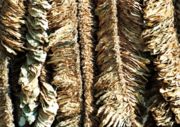
Tobacco can be harvested in several ways. In the oldest method, the entire plant is harvested at once by cutting off the stalk at the ground with a sickle. In the nineteenth century, bright tobacco began to be harvested by pulling individual leaves off the stalk as they ripened. The leaves ripen from the ground upwards, so a field of tobacco may go through several so-called "pullings," more commonly known as topping (topping always refers to the removal of the tobacco flower before the leaves are systematically removed and, eventually, entirely harvested. The stalks are left as compost to postpone over-farming and thus soil lacking essential nutrients for a strong crop the following year. "Cropping," "Topping," "Pulling", and "Priming" are terms for removing mature leaves from tobacco crops. Leaves are cropped as they ripen, from the bottom to the top of the stalk. The first crop of leaves, located near the base of the tobacco stalk, are called "sand lugs" in more rural southern tobacco states, where these leaves are often against the ground, coated with sand and clay, splashed upon them when it rains. Sand lugs weigh the most, and are most difficult to work with. Their weight is due to their large size and the added weight of caked-on soil; slaves would "lug" each stack to the stringer, a typically female slave who bundled each stack of leaves. Eventually workers carried the tobacco and placed it on sleds or trailers. As the industrial revolution approached America, the harvesting wagons used to transport leaves were equipped with man powered stringers, an apparatus which used twine to attach leaves onto a poll. In modern times, large fields are harvested by a single piece of farm equipment, although topping the flower and in some cases the plucking of immature leaves is still done by hand.
Some farmers still use "tobacco harvesters." They are not very efficient yet highly cost effective for harvesting premium and rare strains of tobacco. The harvester trailer for in-demand crops are now pulled by gasoline fueled tractors. The croppers pull the leaves off in handfuls, and pass these to the "stringer", which bundles the leaves to a four-sided pole with twine. These poles are hung until the harvester is full; the poles are then placed in much larger wagon to be pulled by modern farm tractors to their destination. For rare tobaccos, they are often cured on the farm. Traditionally, the slaves who cropped and pulled pulled had a very tough time with the first pull of the large, dirty, base leaves in particular. The leaves slapped their faces, dark tobacco sap which dries into a pitch black tar covered their bodies, and the soil stuck to the tar. There was one perk, however: nicotine in tobacco acts as a powerful insecticide. Slaves could enjoy a bug free day of forced labor when harvesting tobacco. The croppers were men, and the stringers, seated on the higher elevated seats were women or children. The harvesters had places for one team of ten workers: eight people cropping and stringing, plus a packer who moved the heavy strung poles of wet green tobacco from the stringers and packed them onto the pallet section of the harvester, plus a horseman, making the total crew of each harvester 10 people. Interestingly, the outer seats were suspended from the harvester - slung out over to fit into the aisles of tobacco. As these seats were suspended it was important to balance the weight of the two outside teams (similar to a playground see-saw). Having too heavy or light a person in an unbalanced combination often resulted in the harvester tipping over especially when turning around at the end of a lane. Water tanks were a common feature on the harvester due to heat, and danger of dehydration.
Curing
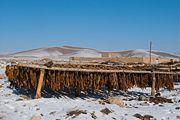
Cut plants or pulled leaves are immediately transferred to tobacco barns (kiln houses), where they will be cured. Curing methods vary with the type of tobacco grown, and tobacco barn design varies accordingly.
Air-cured tobacco is hung in well-ventilated barns and allowed to dry over a period of four to eight weeks.
Fire-cured tobacco is hung in large barns where fires of hardwoods are kept on continuous or intermittent low smoulder and takes between three days and ten weeks, depending on the process and the tobacco.
Flue-cured tobacco was originally strung onto tobacco sticks, which were hung from tier-poles in curing barns (Aus: kilns, also traditionally called Oasts). These barns have flues which run from externally fed fire boxes, heat-curing the tobacco without exposing it to smoke, slowly raising the temperature over the course of the curing. The process will generally take about a week.
Traditional curing barns in the U.S. are falling into disuse, as the trend toward using prefabricated metal curing machines within factories allows greater efficiency. These machines are also found on location at tobacco farms in 2nd world countries.
Curing and subsequent aging allows for the slow oxidation and degradation of carotenoids in tobacco leaf. This produces certain compounds in the tobacco leaves very similar and give a sweet hay, tea, rose oil, or fruity aromatic flavor that contribute to the "smoothness" of the smoke. Starch is converted to sugar which glycates protein and is oxidized into advanced glycation endproducts (AGEs), a caramelization process that also adds flavor. Inhalation of these AGEs in tobacco smoke contributes to atherosclerosis and cancer.
Non-aged or low quality tobacco is often flavored with these naturally occurring compounds. Tobacco flavoring is a significant source of revenue for the international multi-million dollar flavor and fragrance industry.
The aging process continues for a period of months and often extends into the post-curing harvest process.
After tobacco is cured, it is moved from the curing barn into a storage area for processing. If whole plants were cut, the leaves are removed from the tobacco stalks in a process called stripping. For both cut and pulled tobacco, the leaves are then sorted into different grades. In colonial times, the tobacco was then "prized" into hogsheads for transportation. In bright tobacco regions, prizing was replaced by stacking wrapped "hands" into loose piles to be sold at auction. Today, most cured tobacco is baled before sales are made under pre-sold contracts.
Tobacco products
Snuff
Snuff is a generic term for fine-ground smokeless tobacco products. Originally the term referred only to dry snuff, a fine tan dust popular mainly in the eighteenth century. This is often called "Scotch Snuff", a folk-etymology derivation of the scorching process used to dry the cured tobacco by the factory. Snuff powder originated in the UK town of Great Harwood and was famously ground in the town's monument prior to local distribution and transport further up north to Scotland.
Types of Snuff
European (dry) snuff is intended to be sniffed up the nose. Snuff is not "snorted" because snuff shouldn't get past the nose, i.e.; into sinuses, throat or lungs. European snuff comes in several varieties: Plain, Toast (fine ground - very dry), "Medicated" (menthol, camphor, eucalyptus, etc.), Scented, and Schmalzler, a German variety. The major brand names of European snuffs are: Toque Tobacco (UK), Bernards (Germany), Fribourg & Treyer (UK), Gawith (UK), Gawith Hoggarth] (UK), Hedges (UK), Lotzbeck (Germany), McChrystal's (UK), Pöschl (Germany) and Wilsons of Sharrow (UK), TUTUN-CTC (Moldova).
American (moist) snuff is much stronger, and is intended to be dipped. It comes in two varieties—"sweet" and "salty." Until the early 20th century, snuff dipping was popular in the United States among rural people, who would often use sweet barkless twigs to apply it to their gums. Popular brands are Tube Rose and Navy.
Moist snuff is also referred to as dipping tobacco or smokeless tobacco, and its use is known as dipping. In the Southern states, taking a "dip" of moist snuff is called "putting a rub in," the moist snuff in the mouth is known as a "rub." This is occasionally referred to as " snoose" in New England and the Midwest and is derived from the Scandinavian word for snuff, " snus." Like the word, the origins of moist snuff are Scandinavian, and the oldest American brands indicate that by their names. However, snuff may also be called a "dinger" or a "lipper" in New England, and its user may "pack a dinger." American Moist snuff is made from dark fire-cured tobacco that is ground, sweetened, and aged by the factory. Prominent North American brands are Copenhagen, Skoal, Timber Wolf, Chisholm, Grizzly, and Kodiak.
Some modern smokeless tobacco brands, such as Kodiak, have an aggressive nicotine delivery. This is accomplished with a higher dose of nicotine than cigarettes, a high pH level (which helps nicotine enter the blood stream faster), and a high portion of unprotonated (free base) nicotine.
It has been suggested by The Economist magazine that the ban on smoking tobacco indoors in some areas, such as Britain and New York City, may lead to a resurgence in the popularity of snuff as an alternative to tobacco smoking. Although the large-scale closure of British mines in the 1980s deprived the snuff industry of its major market since snuff became unfashionable (miners took snuff underground instead of smoking to avoid lethal explosions and fires), sales at Britain's largest snuff retailer have reportedly been rising at about 5% per year.
Chewing tobacco
Chewing is one of the oldest ways of consuming tobacco leaves. Native Americans in both North and South America chewed the leaves of the plant, frequently mixed with lime. Modern chewing tobacco is produced in three forms: twist, plug, and scrap. A few manufacturers in the United Kingdom produce particularly strong twist tobacco meant for use in smoking pipes rather than chewing. These twists are not mixed with lime although they may be flavored with whiskey, rum, cherry or other flavours common to pipe tobacco.
Twist is the oldest form. One to three high-quality leaves are braided and twisted into a rope while green, and then are cured in the same manner as other tobacco. This was originally devised by sailors due to fire hazards of smoking at sea, and until recently this was done by farmers for their personal consumption, in addition to other tobacco intended for sale. Modern twist is occasionally lightly sweetened. It is still sold commercially, but rarely seen outside of Appalachia. Popular brands are Mammoth Cave, Moore's Red Leaf, and Cumberland Gap. Users cut a piece off the twist and chew it, expectorating.
Plug chewing tobacco is made by pressing together cured tobacco leaves in a sweet (often molasses-based) syrup. Originally this was done by hand, but since the second half of the 19th century leaves were pressed between large tin sheets. The resulting sheet of tobacco is cut into plugs. Like twist, consumers sometimes cut, but more often bite off, a piece of the plug to chew. Major brands are Axton's, Days Work, and Cannonball.
Scrap, or looseleaf chewing tobacco, was originally the excess of plug manufacturing. It is sweetened like plug tobacco, but sold loose in bags rather than a plug. Looseleaf is one of the more popular forms of tobacco in modern times. Among those, popular brands are Red Man, Beechnut, Mail Pouch and Southern Pride. Looseleaf chewing tobacco can also be dipped.
Gutka
Gutka (also spelled gutkha, guttkha, guthka) is a preparation of crushed betel nut, tobacco, and sweet or savory flavorings. It is manufactured in India and exported to a few other countries. A mild stimulant, it is sold across India in small, individual-size packets. It is consumed much like chewing tobacco, and like chewing tobacco it is considered responsible for oral cancer and other severe negative health effects.
Used by millions of adults, it is also marketed to children. Some packaging does not mention tobacco as an ingredient, and some brands are pitched as candies - featuring packaging with children's faces and are brightly colored. Some are chocolate-flavored, and some are marketed as breath fresheners.
Tobacco water
Tobacco water is a traditional organic insecticide used in domestic gardening. Tobacco dust can be used similarly.
It is produced by boiling strong tobacco in water, or by steeping the tobacco in water for a longer period. When cooled the mixture can be applied as a spray, or 'painted' on to the leaves of garden plants, where it will prove deadly to insects.
Basque angulero fishermen kill immature eels (elvers) in an infusion of tobacco leaves before parboiling them in salty water for transportation to market as angulas, a seasonal delicacy.
Tobacco paste treatment for stinging insects
Topical tobacco paste is sometimes recommended as a treatment for wasp, hornet, fire ant, scorpion, and bee stings. An amount equivalent to the contents of a cigarette is mashed in a cup with about a 0.5 to 1 teaspoon of water to make a paste that is then applied to the affected area. Paste has a diameter of 4 to 5 cm (1.5 to 2 inches) and may need to be moistened in dry weather. If made and applied immediately, complete remission is common within 20–30 minutes, at which point the paste can be removed. The next day there may be a some residual itching, but virtually no swelling or redness. There seems to be no scientific evidence, as yet, that this common home remedy works to relieve pain. For about 2 percent of people, allergic reactions can be life-threatening and require emergency treatment. For more on this, see bee stings.
